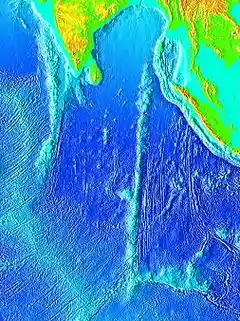Chagos–Laccadive Ridge

The Chagos–Laccadive Ridge (CLR), also known as the Chagos–Laccadive Plateau,[1] is a prominent volcanic ridge and oceanic plateau extending between the Northern and the Central Indian Ocean.
Extending from c. 10°S to 15°N, the CLR includes the Laccadive, Maldives, and Chagos archipelagos and can be divided into three corresponding blocks, of which the first is continental and the two latter are oceanic. The CLR is asymmetrical with a steeper eastern slope and has an average depth of less than 1,000 m (3,300 ft). It formed south of or near the Equator together with the remaining western continental margin of India, when India separated first from Madagascar in the Mid-Cretaceous and then from the Seychelles Islands in the Late Cretaceous.[2]
Extent
The CLR extends northward for c. 2,550 km (1,580 mi) from 10°S at the southern end of the Chagos Archipelago to 14°N around the Adas Bank.[3] The second element of the name is for the Laccadive Islands, among the islands of Lakshadweep. ("Laccadive" is a form of the name "Lakshadweep".) The islands of Chagos, Maldives and Lakshadweep are the above-water parts of the Chagos–Laccadive Ridge.
The Laccadive Ridge, the northern part of the CLR, parallels the Indian west coast (8°N–16°N) and has an average width of 270 km (170 mi). It is separated from the flanking basins by fault scarps made of thick, high-density crust. It is made of thinned continental crust marked by the volcanism that occurred near the KT-boundary c. 66 Ma.[4][5]
The western coastal margin of the Indian subcontinent was affected by two large igneous provinces at 85 Ma and 65 Ma. This left a complex of ridges that run parallel to the west coast of which the Laccadive Ridge is the larger. A complex of considerably smaller ridges constitutes a northern extension to the CLR. The Laxmi Ridge, the larger of these, is made of continental crust and formed during the Seychelles-India breakup.[6] East of the Laxmi Ridge in the Laxmi Basin, the Panikkar Ridge is made of stretched continental crust and has a similar tectonic history. In contrast, the Palitana Ridge north of the Panikkar Ridge probably represents an extinct spreading centre and on the nearby shelf and slope a lineament, known as the Prathap Ridge Complex, is similarly made of oceanic crust and both are probably leftovers from the India–Madagascar breakup.[7][8]
Formation
The vast Chagos–Laccadive Ridge contains a considerable amount of volcanic rock, as does the southern part of the Mascarene Plateau. Although the Chagos–Laccadive Ridge is an aseismic ridge, between 1965 and 1970 an unusual, isolated swarm of earthquakes occurred on the west side of the Great Chagos Bank at approximately 6°00′S 71°20′E.[9] It is unknown, but of considerable interest, how much continental crust exists at depth beneath the ridge.
See also
References
Notes
- Geographical Names 2003
- Nair, Anand & Rajaram 2013, Morpho-tectonic elements of the WCMI, pp. 80–81
- Mukhopadhyay, Ghosh & Iyer 2017, pp. 43–44
- Ajay et al. 2010, Physiographic and tectonic settings, pp. 804–806
- Nair, Anand & Rajaram 2013, Discussion, pp. 89–90
- Subrahmanyam & Chand 2006, p. 170
- Krishna, Rao & Sar 2006, Origin of the Panikkar Ridge, pp. 2, 8–9; Figg. 1, 9, pp. 24, 35
- Subrahmanyam & Chand 2006, p. 169
- Seth 1978, Abstract
Sources
- Ajay, K. K.; Chaubey, A. K.; Krishna, K. S.; Rao, D. G.; Sar, D. (2010). "Seaward dipping reflectors along the SW continental margin of India: Evidence for volcanic passive margin" (PDF). Journal of Earth System Science. 119 (6): 803–813. Bibcode:2010JESS..119..803A. doi:10.1007/s12040-010-0061-2. Retrieved 14 July 2018.
- "Chagos-Laccadive Plateau: Undersea Features". Geographical Names. 2003-09-17. Retrieved 14 July 2018.
- Krishna, K. S.; Rao, D. G.; Sar, D. (2006). "Nature of the crust in the Laxmi Basin (14°–20°N), western continental margin of India". Tectonics. 25 (1): TC1006. Bibcode:2006Tecto..25.1006K. CiteSeerX 10.1.1.595.6101. doi:10.1029/2004TC001747.
- Mukhopadhyay, R.; Ghosh, A. K.; Iyer, S. D. (2017). The Indian Ocean nodule field: geology and resource potential (2nd ed.). Elsevier. ISBN 9780444637628. Retrieved 14 July 2018.
- Nair, N.; Anand, S. P.; Rajaram, M. (2013). "Tectonic framework of laccadive Ridge in western Continental margin of India" (PDF). Marine Geology. 346: 79–90. Bibcode:2013MGeol.346...79N. doi:10.1016/j.margeo.2013.08.009. Retrieved 15 July 2018.
- Seth, S. (1978). "An earthquake swarm on the Chagos?Laccadive Ridge and its tectonic implications". Geophysical Journal International. 55 (3): 577–588. Bibcode:1978GeoJ...55..577S. CiteSeerX 10.1.1.837.7160. doi:10.1111/j.1365-246X.1978.tb05928.x.
- Subrahmanyam, C.; Chand, S. (2006). "Evolution of the passive continental margins of India—a geophysical appraisal". Gondwana Research. 10 (1–2): 167–178. doi:10.1016/j.gr.2005.11.024.
- Verzhbitsky, E. V. (2003). "Geothermal regime and genesis of the Ninety-East and Chagos-Laccadive ridges". Journal of Geodynamics. 35 (3): 289–302. Bibcode:2003JGeo...35..289V. doi:10.1016/S0264-3707(02)00068-6.
External links
- Ashalatha, B.; Subrahmanyam, C.; Singh, R. N. (1991). "Origin and compensation of Chagos-Laccadive Ridge, Indian Ocean, from admittance analysis of gravity and bathymetry data". Earth and Planetary Science Letters. 105 (1–3): 47–54. Bibcode:1991E&PSL.105...47A. doi:10.1016/0012-821X(91)90119-3.
- Hydrographic Description (Indian Ocean Pilot)